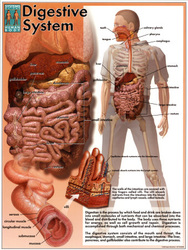Like all other organisms, the human body is alive in many ways. Because the digestive system is apart of the human body, it must follow the 10 COL's in order to properly function and carry out it's many jobs. The digestive system also works hard to sustain balance, also known as homeostasis, in the body at all times. Now, we will venture into the digestive system to see how it preforms the 10 COL's, and keeps the body rich of nutrients.
Characteristics of Life
The digestive system performs many Characteristics of Life, including:
Nutrition: Nutrition is when organisms obtain energy from their environment. This is performed by separating waste from important nutrients your body needs to function. In the villi of the small intestine, nutrients get sent to the capillaries and the lacteal while waste is moved to the large intestine. The nutrients in the capillaries then get sent all around the body, supply it with rich nutrients important for functioning.
Synthesis: When you digest things, the body breaks down food by either using mechanical or chemical digestion. Synthesis, which is making big things from little things, can only be done by using the nutrients digested to create something bigger which the body can use. Think of it like this, in order to build a Lego structure like a house, you must start with the small Lego pieces first, in order to get your final structure or "masterpiece". The same thing works in the digestive system, it starts by breaking big things into little things, and then from those little things building them into bigger things the body can re-use.
The digestive system also performs, respiration; burning food for fuel, and metabolism; the set of chemical reactions needed by all living things.
Nutrition: Nutrition is when organisms obtain energy from their environment. This is performed by separating waste from important nutrients your body needs to function. In the villi of the small intestine, nutrients get sent to the capillaries and the lacteal while waste is moved to the large intestine. The nutrients in the capillaries then get sent all around the body, supply it with rich nutrients important for functioning.
Synthesis: When you digest things, the body breaks down food by either using mechanical or chemical digestion. Synthesis, which is making big things from little things, can only be done by using the nutrients digested to create something bigger which the body can use. Think of it like this, in order to build a Lego structure like a house, you must start with the small Lego pieces first, in order to get your final structure or "masterpiece". The same thing works in the digestive system, it starts by breaking big things into little things, and then from those little things building them into bigger things the body can re-use.
The digestive system also performs, respiration; burning food for fuel, and metabolism; the set of chemical reactions needed by all living things.
Homeostasis and Corresponding Systems
Maintaining Homeostasis in the Digestive System
When you digest food, you are taking out all vitamins and nutrients and excreting the left overs. Nutrients are taken out of the food in chemical and mechanical digestion. Nutrients are taken out by mechanical and chemical digestion by either releasing substances from glands or churning food with stomach fluids. Then the minerals, vitamins,etc, are sent to the blood stream through diffusion and delivered to cells all around the body.
How does the Digestive System Correspond with other Systems?
The digestive system is in charge of breaking down big things, into smaller things. The food we consume is eaten and chewed, (mechanical digestion) and then sent down the esophagus into the stomach, where chemical digestion takes place. Like all systems, the parts of the digestive system all work together so it can get it's job done. When the food is sent to the stomach, it gets tossed an turned and mixed in with other chemicals, which work to break down the large food molecules into tiny ones so they can be digested. when this is preformed, certain toxins get released into the body, and will eventually need to be excreted. this is where the excretory system comes in, the system that is in charge of getting rid of metabolic waste. Once the food is sent through the digestive system, it must find a way to exit the body, which is why the digestive and excretory system work hand and hand.



